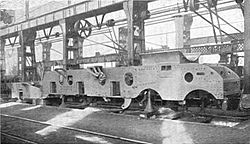This article relies largely or entirely on a single source .(May 2024) |

A locomotive frame is the structure that forms the backbone of the railway locomotive, giving it strength and supporting the superstructure elements such as a cab, boiler or bodywork. The vast majority of locomotives have had a frame structure of some kind. The frame may in turn be supported by axles directly attached to it, or it may be mounted on bogies (known as trucks in American English), or a combination of the two. The bogies in turn will have frames of their own.

